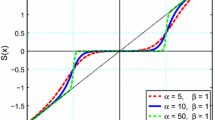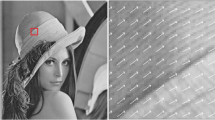Abstract
Sparse representation based on over-complete dictionaries is a hot issue in the field of computer vision and machine learning. In probability theory, over-complete dictionary can be learned by non-parametric Bayesian techniques with Beta Process. However, traditional probabilistic dictionary learning method assumes noise follows Gaussian distribution, which can only remove Gaussain noise. In order to remove outlier or complex noise, we propose a dictionary learning method based on non-parametric Bayesian technology by assuming the noise follows Laplacian distribution. Because the non-conjugacy of Laplacian distribution makes the calculation of posteriors of latent variables more complicate, thus we utilize a superposition of an infinite number of Gaussian distributions to substitute for L1 density function. The weights of mixture Gaussian distribution are controlled by an extra hidden variable. Then the Bayesian inference is applied to learn all the key parameters in the proposed probabilistic model, which avoids the processing of parameter setting and fine tuning. In the experiments, we mainly test the performance of different algorithms in removing salt-and-pepper noise and mixture noises. The experimental results show that the PSNRs of our algorithm are higher 2-4 dB at least than other classic algorithms.


Similar content being viewed by others
References
Aharon M, Elad M, Bruckstein A (2005) K-SVD: design of dictionaries for sparse representation. In: Proceedings of the society of photo-optical instrumentation engineers, vol 5, pp 9–12
Aharon M, Elad M, Bruckstein A M (2005) K-SVD and its non-negative variant for dictionary design. In: Proceedings of the society of photo-optical instrumentation engineers. The International Society for Optical Engineering, pp 327–339
Aharon M, Elad M, Bruckstein A M (2006) The K-SVD: an algorithm for designing of overcomplete dictionaries for sparse representation. IEEE Trans Signal Process 54(11):4311–4322
Akhtar N, Mian A (2017) Nonparametric coupled bayesian dictionary and classifier learning for hyperspectral classification. IEEE Trans Neural Netw Learn Syst 29(9):1–13
Bao C L, Cai J F, Ji H (2013) Fast sparsity-based orthogonal dictionary learning for image restoration. In: IEEE international conference on computer vision, pp 3384–3391
Bibi A, Bernard G (2017) High order tensor formulation for convolutional sparse coding. In: IEEE International conference on computer vision, pp 1790–1798
Choudhury B, Swanson R, Heide F, Wetzstein G, Heidrich W (2017) Consensus convolutional sparse coding. In: IEEE International conference on computer vision, pp 4290–4298
Ding X, Jiang Y, Yue H, Paisley J (2014) Pan-sharpening with a Bayesian nonparametric dictionary learning model. In: International conference on artificial intelligence and statistics, pp 176–184
Engan K, Aase S, Husoy J H (1999) Method of optimal directions for frame design. In: IEEE International conference on acoustics, speech, and signal processing, pp 2443–2446
Griffiths T, Ghahramani Z (2005) Infinite latent feature models and the Indian buffet process. In: International conference on neural information processing systems, pp 475–482
He Y, Sun G, Han J (2016) Optimization of learned dictionary for sparse coding in speech processing. Neurocomputing 173:471–482
Huang Y, Paisley J, Lin Q, Ding X, Zhang X (2014) Bayesian nonparametric dictionary learning for compressed sensing MRI. IEEE Trans Image Process 23(12):5007–5019
Jiang Z, Yang J, Davis L (2011) Learning a discriminative dictionary for sparse coding via label consistent K-SVD. In: IEEE International conference on computer vision and pattern recognition, pp 1697–1704
Lee H, Battle A, Raina R, Ng A (2006) Efficient sparse coding algorithms. In: Advances in neutral information processing systems, pp 801–808
Li S, Tao X, Lu J (2017) Variational inference for nonparametric subspace dictionary learning with hierarchical beta process. In: IEEE international conference on acoustics, speech and signal processing, pp 2691–2695
Mallat S, Zhang Z (1993) Matching pursuit with time-frequency dictionaries. IEEE Trans Signal Process 41(12):3397–3415
Paisley J, Carin L (2009) Nonparametric factor analysis with beta process priors. In: Proceedings of the 26th annual international conference on machine learning, pp 777–784
Papyan V, Romano Y, Sulam J, Elad M (2017) Convolutional dictionary learning via local processing. In: IEEE international conference on computer vision, pp 5306–5314
Protter M, Elad M (2009) Image sequence denoising via sparse and redundant representations. IEEE Trans Image Process 18(1):27–35
Quan Y, Yan H, Hui J (2016) Dynamic texture recognition via orthogonal tensor dictionary learning. In: IEEE International conference on computer vision, pp 73–81
Sertoglu S, Paisley J (2015) Scalable bayesian nonparametric dictionary learning. In: Signal processing conference, pp 2771–2775
Song X, Liu Z, Yang X, Yang J (2014) A parameterized fuzzy adaptive K-SVD approach for the multi-classes study of pursuit algorithms. Neurocomputing 123:131–139
Wang N Y, Wang J D, Yeung D Y (2013) Online robust non-negative dictionary learning for visual tracking. In: IEEE international conference on computer vision, pp 657–664
Yang J, Wright J, Huang T, Ma Y (2008) Image super-resolution as sparse representation of raw image patches. In: IEEE conference on computer vision and pattern recognition, pp 1121–1124
Yang J, Wright J, Huang T, Ma Y (2010) Image super-resolution via sparse representation. IEEE Trans Image Process 19(11):2861–2873
Yang M, Van L, Zhang L (2013) Sparse variation dictionary learning for face recognition with a single training sample per person. In: IEEE international conference on computer vision, pp 689–696
Yin H (2015) Fusion algorithm of optical images and sar with svt and sparse representation. Int J Smart Sens Intell 8(2):1123–1141
Ying F, Lam A, Sato I, Sato Y (2015) Adaptive spatial-spectral dictionary learning for hyperspectral image denoising. In: IEEE international conference on computer vision, pp 343–351
Zhang Q, Li B (2010) Discriminative K-SVD for dictionary learning in face recognition. In: IEEE international conference on computer vision and pattern recognition, pp 2691–2698
Zhang Y, Henao R, Li C, Carin L (2016) Bayesian dictionary learning with gaussian processes and sigmoid belief networks. In: International joint conference on artificial intelligence, pp 2364–2370
Zhao Y, Zhao H, Shang L, Liu T (2014) Immune K-SVD algorithm for dictionary learning in speech denoising. Neurocomputing 137:223–233
Zheng H, Tao D (2015) Discrimintive dictionary learning via fisher discrimination K-SVD algorithm. Neurocomputing 162:9–15
Zhou M, Chen H, Paisley J W, Lu R, Sapiro G, Carin L (2009) Non-parametric bayesian dictionary learning for sparse image representations. In: International conference on neural information processing systems, pp 2295–2303
Zhou M, Yang H, Sapiro G, Dunson D B, Carin L (2011) Dependent hierarchical beta process for image interpolation and denoising. J Mach Learn Res - Proc Track 15:883–891
Zhou M, Chen H, Paisley J, Ren L, Li L, Xing Z, Dunson D, Sapiro G, Carin L (2012) Nonparametric Bayesian dictionary learning for analysis of noisy and incomplete images. IEEE Trans Image Process 21(1):130–44
Acknowledgments
This research was supported by National Natural Science Foundation of China under Grant 61806014, 61772048 and 61672071, in part by the Beijing Natural Science Foundation under Grant 4172003, in part by Beijing Municipal Science and Technology Project KM201910005028, in part by Beijing Municipal Science and Technology Project with no. Z191100009119013.
Author information
Authors and Affiliations
Corresponding author
Additional information
Publisher’s note
Springer Nature remains neutral with regard to jurisdictional claims in published maps and institutional affiliations.
Rights and permissions
About this article
Cite this article
Ju, F., Sun, Y. & Li, M. Non-parametric Bayesian dictionary learning based on Laplace noise. Multimed Tools Appl 80, 35993–36007 (2021). https://doi.org/10.1007/s11042-020-10349-y
Received:
Revised:
Accepted:
Published:
Issue Date:
DOI: https://doi.org/10.1007/s11042-020-10349-y




